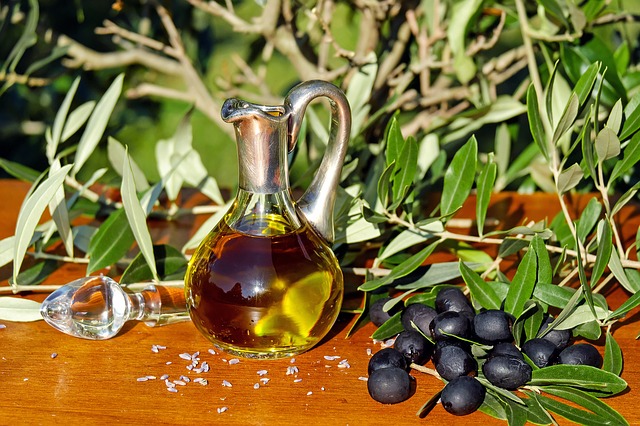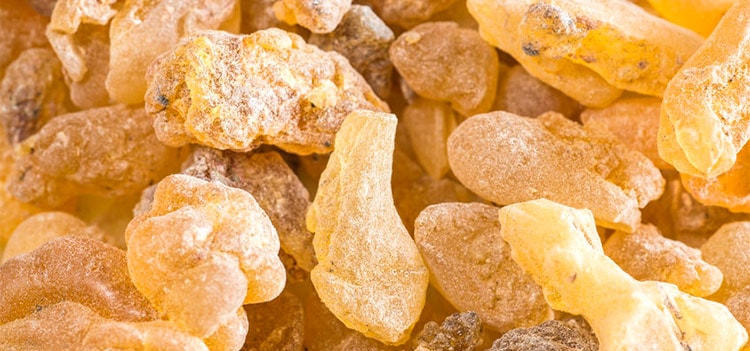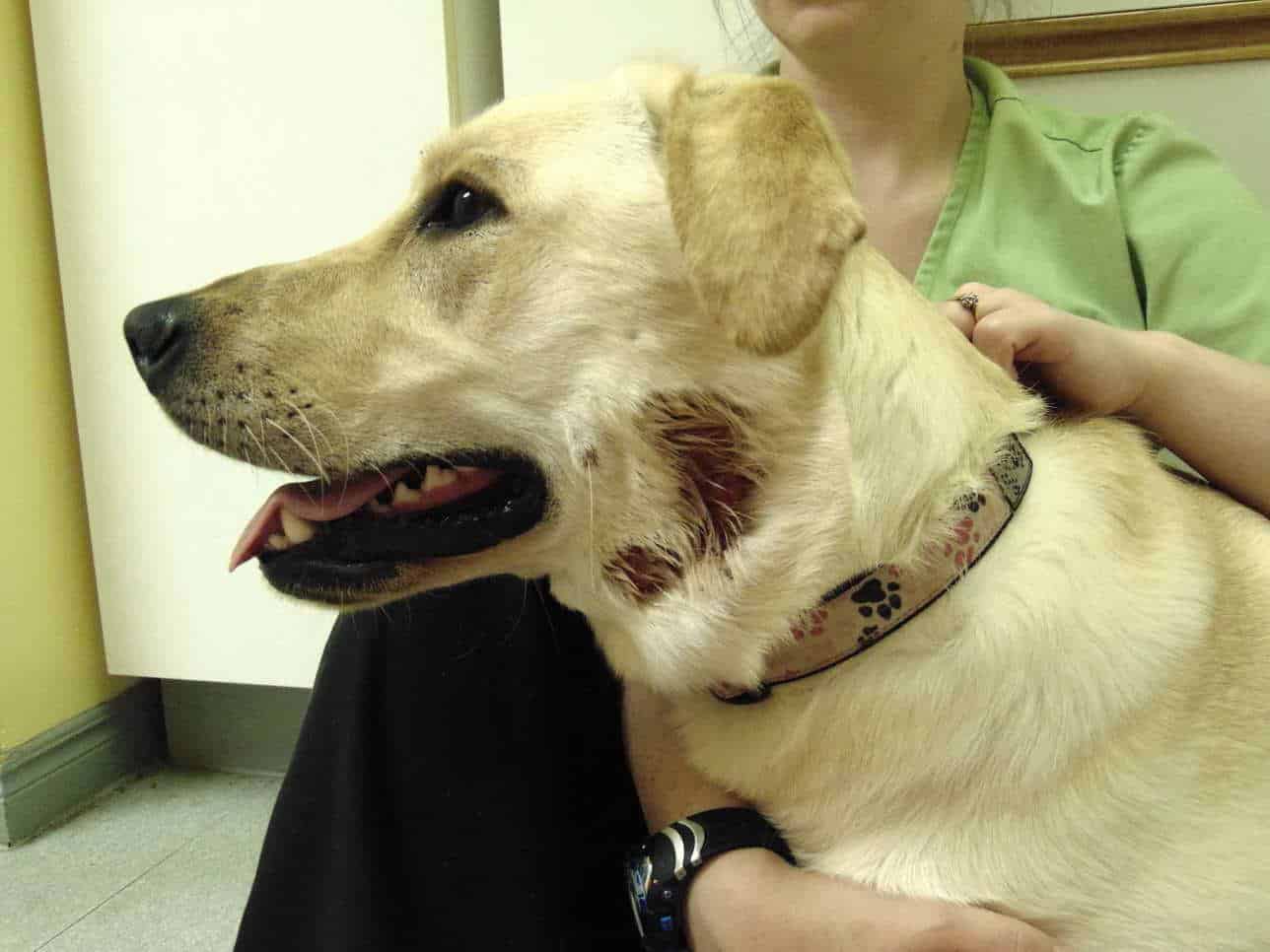Of all skin conditions dogs suffer from, hotspots seem to be the most common.
They are itchy spots that can cause a lot of pain and discomfort in dogs, especially if a dog bites and licks them a lot.
Pus may also ooze from the affected areas as bacterial infection sets in.
You may feel defeated when your dog is wincing in pain caused by hotspots (they are SO itchy!).
Luckily, with the right treatment option, she can recover pretty quickly.
One of them is using the right essential oils to reduce itchiness and soothe the inflamed area.
But which essential oils can you use to relieve hot spots in dogs?
Well, we’ve listed some of the best on this post but before then, let’s learn some basics…
What Are Hot Spots?
Also referred to as acute moist dermatitis or pyotraumatic dermatitis, hot spots are sores or localized areas of skin inflammation and infection on the surface of a dog’s skin.
They are characterized by redness, pain, inflammation, and oozing (which can also cause matted fur).
They can develop anywhere on a dog’s body though the most common areas are around the head, neck, and hip areas.
If you can’t tell whether what your dog is suffering from is hot spots or not, talk to your vet to help you diagnose it properly before you do anything else.
Generally, hot spots themselves are not dangerous to your pup’s health.
But the oozing, irritated lesions can make him experience a significant amount of pain.
And if left unresolved or if their underlying cause isn’t treated, they can cause bacterial infections, irreversible skin damage, and a host of other serious health issues in dogs.
Common causes of hot spots in dogs include:
- Self-inflicted: hot spots may occur when a dog bites, licks, or itches his skin incessantly, creating raw skin, traumatized tissues, and moist scabs
- Soap residue left on a dog’s skin after bath
- Dry skin
- Flea infestation
- Allergic reactions (like protein allergy)
- Over grooming
- Underlying skin conditions
- Minor burns and insect bites
- Anal gland issues
- Injection site reactions
- Scabies and demodex
Essential Oils For Hot Spots
If your dog is suffering from hot spots, the most important things to do to control them are twofold:
- Prevent your canine friend from scratching or chewing the affected areas, which only serves to irritate him further.
- Relieving the irritation and discomfort (which also solve the first problem).
When it comes to relieving your dog of the itching or discomfort that comes with hot spots, there are several ointments that vets and other canine professionals may prescribe for you.
However, many essential oils can also solve the issue just as well, without exposing your dog to harsh chemicals.
For starters, essential oils are concentrated, volatile, aromatic compounds extracted (through distillation or pressing) from plants.
Basically, plants make these compounds to defend themselves against bacteria, fungi, viruses, and insects.
So, one reason why essential oils are often recommended for hot spots and other health conditions in dogs is the fact that they possess potent anti-fungal, antiviral, and antibacterial properties.
They are also associated with amazing nourishing, rejuvenating, and medicinal benefits.
The efficacy of these oils for treating skin issues in dogs are also backed by several studies.
In this study, for instance, therapy done with an essential oil blend produced the same results as a combination of oral and topical medication in managing Malassezia dermatitis.
Without further ado, here’s a roundup of the best essential oils for treating hotspots.
1. Lavender oil

For hotspots, lavender oil is nature’s miracle cure.
For one, it has antifungal properties and is ideal for soothing itchy skin.
If the dog is itching because of a bug bite, the oil will also help reduce the irritation to a great extent.
It is also antibacterial and antimicrobial, which means it inhibits the growth of microorganisms if there are any in your dog’s body.
This also prevents infection that can result in over scratching and over licking.
In addition to being a powerful antiseptic, lavender oil also repels ticks and fleas that love to infect your dog.
Finally, it has calming properties and can help relax a nervous dog. This is an added benefit of using the oil on a canine.
Word of caution: Lavender lacks antioxidant compounds and tends to get easily oxidized when stored, producing oxidized alcohols that can cause allergic reactions in pets.
So, before you use lavender essential oil on your pup, ensure that it is sourced from a reputed source and has not been sitting on the shelves for too long.
2. Coconut Oil
Coconut oil provides a host of benefits to dogs, including:
- Improves skin and coat health by relieving itchy skin issues, clearing up eczema, reducing allergic reactions, boosting coat shine, healing wounds among others.
- Aids dog digestion
- It is marketed as a superfood, so it is believed it can aid weight loss and help control diabetes as well as boost energy levels.
For controlling hot spots, administer orally or topically.
Start with small amounts if you decide to give your dog coconut oil orally.
If you are in doubt, contact your vet about adding the oil to your dog’s diet and how much to give him.
For topical application, simply rub a small amount of the oil (too much will get greasy) on the affected area.
It is advisable to allow the oil to get absorbed for about 30-60 minutes, so consider using a cone or e collar on your dog to prevent him from licking the oil.
Related: How to Make Coconut Oil Spray for Dogs
3. Olive Oil

Loaded with natural anti-oxidants, olive oil is great for revitalizing skin and proving moisturizing balance.
Like coconut oil, you can administer olive oil orally or topically.
Adding a little amount of virgin oil to your pup’s food will nourish her epidermal cells at the deepest level, reducing hot spot symptoms over time.
The recommended dosage is one teaspoon for 30-40 lb dog.
For topical application, just a small amount will do the trick.
Too much of the oil will make your dog’s skin greasy, providing a breeding ground for bacteria and yeast.
Add 5 drops of the oil to a cup of water and apply on your dog’s coat.
Caution: Avoid applying the concentrated oil directly on broken skin because the oil has natural anti-inflammatory properties, which could delay the healing of sores and wounds.
4. Roman Chamomile
Roman chamomile oil is derived from the Chamaemelum nobile or Anthemis nobilis plant.
It is slightly different from the German chamomile which is derived from the Matriaca Recutita or Chamomilla Recutita tree.
It has myriad benefits for dogs, one of which is wound healing.
A group of researchers sought to investigate the effect of Roman chamomile on wounds and found out that it affects the healing of an infected wound positively.
In yet another study, it was discovered that essential oil relieves skin irritations when applied to the skin.
Hotspots fall in the category of skin irritations, which means the oil works with them as well.
It also offers pain relief from a wide range of issues, one of which is repeated scratching and licking of a body part.
5. Frankincense

Also called olibanum, frankincense is a special oil that comes from Boswellia trees that are native to Yemen, Oman, and Somalia.
It is derived by steam distillation of the resin from the tree.
For a long time, pet owners have used frankincense to heal the canine mind and skin.
For one, it boosts blood flow and circulation and goes a long way in fixing the damage on your pooch’s skin caused by the constant scratching and licking.
The essential oil also reduces skin discoloration caused by affected scar tissue on the hotspot region.
In addition, Frankincense is a powerful anti-inflammatory and anti-microbial and will both reduce swelling and combat infections that may arise from the hotspot.
6. Myrrh
Sourced from the gum of the Arabian Commiphora myrrha tree, myrrh essential oil has terpenoids – a group of compounds with both anti-inflammatory and antioxidant properties.
Humans utilize the oil in aromatherapy to relieve cold symptoms, soothe gut upsets, and boost immunity.
For your dog, the oil works to fight inflammation and pain caused by many things including hotspots.
Secondly, myrrh works great as a skin-soothing oil as it delivers emotional, spiritual, and mental benefits for your dog.
Canines with hotspots tend to be very agitated and anxious perhaps from the pain and discomfort.
Myrrh triggers a sense of connection and helps your pup realize that her actions will create a certain reaction that she will not like.
As a result, it can help her to stop scratching and licking herself on repeat.
7. Calendula

Calendula is also a fantastic essential oil for hotspots on dogs.
It is anti-fungal, anti-bacterial, and anti-inflammatory.
In human studies, it was discovered that people who used a combination of aloe vera and calendula showed better symptoms of swelling, redness, and bruising.
The same benefits can be applied to your dogs as well.
The oil is also an anti-oxidant and will neutralize any negative effects of oxidative stress in the canine’s body.
8. Yarrow
Yarrow is an expensive essential oil with beautiful color and a pleasant smell.
If you can afford it, go for it as it possesses anti-inflammatory, antirheumatic, haemostateic, astringent, and anti-spasmodic properties.
When it comes to healing wounds, the essential oil works like charm.
It was used in ancient Greece for this very reason.
One study revealed that the oil increases fibroblasts, special cells used to regenerate connective tissues and help the dog’s body recover after an injury.
9. Jojoba

A dog with sores or hotspots can greatly benefit from Jojoba oil.
For one, it speeds up wound healing as seen in this study.
The oil does this by triggering collagen synthesis in vivo tissues thereby assisting the skin in its rejuvenation efforts.
It also has great antibacterial and antioxidant properties to reduce swelling and oxidative stress respectively.
Lastly, jojoba contains vitamins and minerals that promote the softness and lushness of the skin.
10. Neem Oil
Neem Oil has strong anti-inflammatory, anti-bacterial, and anti-fungal properties, making it useful for relieving itchy skin, fungal infections, insect bites, dry skin, and eczema in dogs.
11. Sweet Marjoram

Tea or extract derived from the leaves of sweet marjoram has been shown to possess antimicrobial and anti-inflammatory properties.
Whether it is combating bacteria and fungi that cause infections or reducing swelling from hotspots, the oil can do it all.
Marjoram also promotes blood flow and circulation and helps heal a host of issues including nerve pain, digestive disorders, and depression.
12. Baobab Oil
Rich in omega 3 fatty acids and a wide range of natural vitamins, Baobab oil is known to relieve itching, dryness, and eczema in dogs.
It gets absorbed easily, has no greasy feel, and is non-clogging.
Top Tips For Using Essential Oils For Hot Spots On Dogs
I. Not all essential oils are good for your dog
Some dogs tend to be sensitive to higher concentrations or blends of certain essential oils, including clove, camphor, oregano, thyme, wintergreen, peppermint, cassia, and mountain savory.
So be careful when using these oils on your dog.
If you have to use them or their blends, dilute heavily and watch your pup for any form of a weird reaction.
Most importantly, avoid essential oils that are considered to be toxic to dogs like pennyroyal, sweet birth, ylang-ylang, pine, yarrow, and wintergreen among others.
Learn more here: Which Essential Oils are Toxic to Dogs?
II. Add Unrefined Sea Salt
Consider boosting the effectiveness of the essential oil you choose by adding unrefined sea salt to it.
Unrefined sea salt is known to heal all kinds of wounds.
Add about ½ teaspoon of the essential oil to 1 cup of sea salt.
Then dissolve 1 tablespoon of the mixture in ¼ cup of cool water and spray on the affected area.
III. Dilute with carrier oils
While you can tolerate 100% of essential oils, that’s not true of your dog.
Your pup has an acute sense of smell, so it is best to use essential oils that are diluted with carrier oils.
Some of the most recommended carrier oils (due to their ability to fight infection, prevent scarring and stimulate cell growth) include coconut oil, kukui nut oil, rosehip seed oil, grapeseed, and tamanu oil.
Dilute at a ratio of at least one part of essential oil to 50 parts of your favorite carrier oil.
The rate of dilution should be doubled for toy breeds (or dogs under 20 pounds) and senior dogs.
IV. Avoid using essential oils on puppies
Wait until they are 8 weeks old (for medium and large dog breeds) to 10 weeks (for toy and small breeds).
V. Watch out for your pup’s eyes and ears
Avoid applying or spraying the essential oils near your dog’s eyes or dropping in their ear canals or areas with soft tissues.
VI. Most importantly, CONSULT YOUR VET
Please note the caps—we are serious about this last tip.
Essential oils can have undesirable side effects on your dog and some can even be toxic to your pet.
Besides, many other health conditions (besides hot spots) may cause itching, scratching, and soreness in dogs.
So, always consult your vet before administering essential oils for more professional insights on how to use the oils and for proper diagnosis of your dog’s condition.
Even if you feel that your pup is healthy, consult your vet to ensure that there are no underlying issues.
Parting Thoughts
No canine deserves to go through the pain and discomfort of having hotspots.
Even if the condition is mild, it can negatively affect the health and wellbeing of the pup in more ways than one.
The essential oils listed above may alleviate the problem and give your pup relief from the discomfort.
The trick is to dilute the oils sufficiently and use a carrier oil to make it safe for your furry friend.
Related Posts:
10 Essential Oils For Dogs that Lick Their Paws (Excessively)
12 Essential Oils for Dog Gum Disease
13 Essential Oils for Dog Seizures
Is Orange Essential Oil Safe For Dogs?
Is Diffusing Peppermint Oil Safe for Dogs?
Image sources: 1, 2, 3
As an Amazon Associate, we may receive a small commission from qualifying purchases but at no extra cost to you. Learn more. Amazon and the Amazon logo are trademarks of Amazon.com, Inc, or its affiliates.

